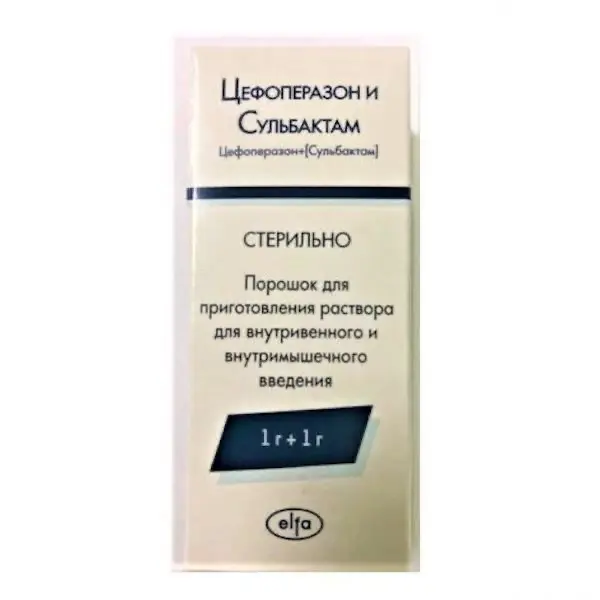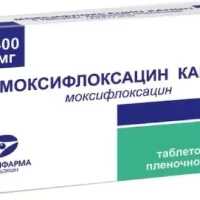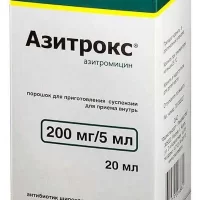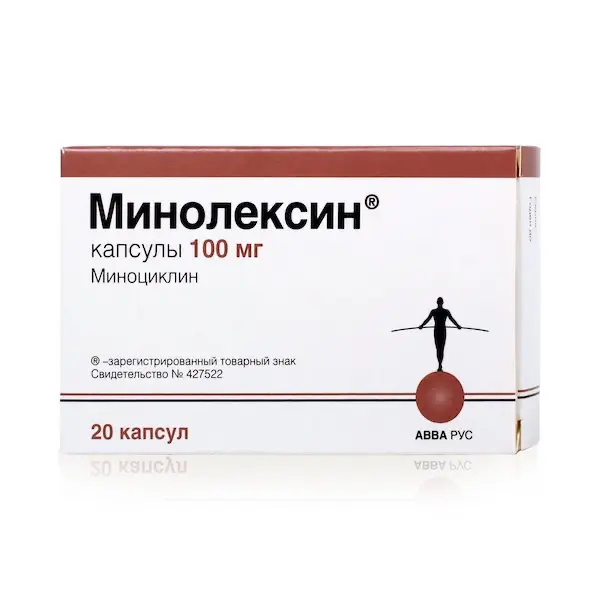Description
Cefoperazone+Sulbactam Pharmacodynamics
The antibacterial component of cefoperazone/sulbactam is cefoperazone, a third generation cephalosporin, which acts on sensitive microorganisms during their active reproduction by inhibiting the biosynthesis of cell wall mucopeptide.
Sulbactam has no clinically significant antibacterial activity (except for Neisseriaceae and Acinetobacter). However, it has been observed to be an irreversible inhibitor of most of the major beta-lactamases produced by microorganisms that are resistant to beta-lactam antibiotics.
The ability of sulbactam to prevent destruction of penicillins and cephalosporins by resistant microorganisms was confirmed in studies using resistant strains, against which sulbactam had pronounced synergism with penicillins and cephalosporins. In addition, sulbactam interacts with some penicillin-binding proteins, so cefoperazone/sulbactam often has a more pronounced effect on sensitive strains than cefoperazone alone.
The combination of cefoperazone and sulbactam is active against all microorganisms sensitive to cefoperazone. In addition, it is synergistic against various microorganisms, primarily: Haemophilus influenzae, Bacteroides spp., Staphylococcus spp., Acinetobacter calcoaceticus, Enterobacter aerogenes, Escherichia coli, Proteus mirabilis, Klebsiella pneumoniae, Morganella morganii, Citrobacter freundii, Enterobacter cloacae, Citrobacter diversus.
Cefoperazone/sulbactam is active in vitro against a wide range of clinically relevant microorganisms.
Gram-positive microorganisms.
Staphylococcus aureus (producing and not producing penicillinase), Staphylococcus epidermidis, Streptococcus pneumoniae, Streptococcus pyogenes (group A beta-hemolytic streptococcus), Streptococcus agalactiae (group B beta-haemolytic streptococcus), most other strains of beta-haemolytic streptococci, many strains of Streptococcus faecalis (enterococci).
Gram-negative microorganisms.
Escherichia coli, Klebsiella spp., Enterobacter spp., Citrobacter spp., Haemophilus influenzae, Proteus mirabilis, Proteus vulgaris, Morganella morganii, Providencia rettgeri, Providencia spp., Serratia spp. (including Serratia marcescens), Salmonella spp. and Shigella spp, Pseudomonas aeruginosa and some other Pseudomonas spp., Acinetobacter calcoaceticus, Neisseria gonorrhoeae, Neisseria meningitidis, Bordetella pertussis, Yersinia enterocolitica.
Anaerobic microorganisms.
Gram-negative bacilli (including Bacteroides fragilis, other Bacteroides spp. and Fusobacterium spp.)
Gram-positive and gram-negative cocci (including Peptococcus spp., Peptostreptococcus spp. and Veillonella spp.)
Gram-positive bacilli (including Clostridium spp., Eubacterium spp. and Lactobacillus spp.)
Indications
The drug Cefoperazone+Sulbactam is indicated for the treatment of the following infections, caused by susceptible microorganisms:
– Upper and lower respiratory tract infections;
– Infections of the urinary tract;
– Peritonitis, cholecystitis, cholangitis and other intra-abdominal infections;
– Sepsis;
– Meningitis;
– Skin and soft tissue infections;
– Bone and joint infections;
– Gonorrhea;
– Inflammatory diseases of the pelvic organs, endometritis and other infections of the genital tract.
Contraindications
Cefoperazone/sulbactam is contraindicated in patients with hypersensitivity to penicillins, sulbactam, cefoperazone, or any other cefaposporins.
Caution:
Severe renal and hepatic impairment.
Newborns, including premature infants.
Use during pregnancy and during breast-feeding:
Adequate clinical studies of the use of Cefoperazone+sulbactam in pregnant women have not been conducted. Cefoperazone and sulbactam penetrate through the placental barrier and into the breast milk.
During pregnancy and lactation the drug is used only if the expected benefits to the mother exceed the potential risk to the fetus and newborn.
Dosage and administration method
- Intravenous (IV) and intramuscular (IM).
- Administration in adults
- In adults, cefoperazone + sulbactam is recommended for use in the following daily doses:
- Cefoperazone+Sulbactam ratio (mg) Sulbactam dose (mg) Cefoperazone dose (mg)
- 1:1 2000-4000 1000-2000 1000-2000
- The daily dose should be divided into equal portions and administered every 12 hours.
- In severe or refractory infections, the daily dose of cefoperazone+sulbactam may be increased to 8000 mg with a 1:1 ratio of the main components (i.e., 4000 mg of cefoperazone). Patients receiving cefoperazone+sulbactam in a 1:1 ratio may require additional administration of cefoperazone. The dose should be divided in equal portions and administered every 12 hours.
- The recommended maximum daily dose of sulbactam is 4000 mg.
- Administration in renal impairment
- In patients with creatinine clearance of 15-30 ml/min the maximum dose of sulbactam is 1000 mg every 12 hours (maximum daily dose of sulbactam is 2000 mg), and in patients with creatinine clearance less than 15 ml/min the maximum dose of sulbactam is 500 mg every 12 hours (maximum daily dose of sulbactam is 1000 mg).
- In severe infections, additional administration of cefoperazone may be required.
- Pharmacokinetics of sulbactam is significantly changed during hemodialysis. T1/2 of cefoperazone from serum is slightly reduced during hemodialysis. Therefore, the drug administration should be planned after dialysis.
- Administration in hepatic dysfunction
- Dosage changes may be required in cases of severe biliary obstruction, severe liver disease, as well as in cases of impaired renal function combined with any of these conditions.
- In patients with hepatic impairment and concomitant renal impairment it is necessary to monitor the serum concentration of cefoperazone and adjust the dose if necessary.
- If daily dose of cefoperazone does not exceed 2000 mg, there is no need to monitor its serum concentrations (see section “Cautions”).
- Administration in children
- In children, cefoperazone+sulbactam is recommended in the following daily doses:
- Cefoperazone+Sulbactam dosage ratio
- (mg/kg/day) Sulbactam dose
- (mg/kg/day) Cefoperazone dose
- (mg/kg/day)
- 1:1 40-80 20-40 20-40
- The dose should be divided in equal parts and administered every 6-12 hours.
- In severe or refractory infections, the daily dose may be increased to 160 mg/kg/day with a 1:1 basic component ratio. The daily dose is divided into 2-4 equal parts.
- Administration in infants
- During the first week of life, the drug should be administered every 12 hours in neonates. Maximal daily dose of sulbactam in children should not exceed 80 mg/kg/day.
- Preparation of solutions for parenteral use
- Dilution:
- Total dose (mg) Equivalent doses of cefoperazone+sulbactam (mg) Solvent volume, ml Maximum final concentration, (mg/ml)
- 500 250 + 250 1,7 125 + 125
- 1000 500 + 500 3,4 125 + 125
- 2000 1000 + 1000 6,7 125 + 125
- Intramuscular administration:
- Preparation of solution using lidocaine. A 2% lidocaine hydrochloride solution can be used to prepare a solution for intramuscular administration; however, it should not be used for initial dissolution, given their incompatibility. Compatibility can be achieved by two-step preparation of the solution – initially the powder is dissolved in sterile water for injection and then diluted with 2% lidocaine hydrochloride solution. The total volume of the solvent is 6.7 ml. The final solution will contain cefoperazone/sulbactam at a ratio of 125 mg/125 mg in 1 mL of 0.5% lidocaine solution.
- Intravenous administration:
- To prepare the infusion solution, dilute 2000 mg (1000 mg+1000 mg) of Cefoperazone+Sulbactam in an initial volume of 6.7 mL of one of the following infusion solutions: 5% dextrose solution, 5% dextrose solution in 0.225% sodium chloride solution, 5% dextrose solution in 0.9% sodium chloride solution, 0.9% sodium chloride solution, or water for injection, and then diluted to 20 ml of the initial solution.
- Preparation of solution using Ringer’s Lactate
- Since Ringer’s lactate is not suitable for initial dilution, the solution is prepared in two steps: first using water for injection (see table above) and then diluting the resulting solution with Ringer’s lactate to a sulbactam concentration of 5 mg/ml (2 ml of the initial solution is diluted in 50 ml of Ringer’s lactate or 4 ml in 100 ml of Ringer’s lactate). The infusion is carried out for 15-60 min.
- For intravenous injection, the contents of each vial should be dissolved in 6.7 ml of one of the solvents described in the preparation of solution for infusion (see above) and administered for at least 3 min. The reconstituted solution is stored for 24 h at room temperature.





